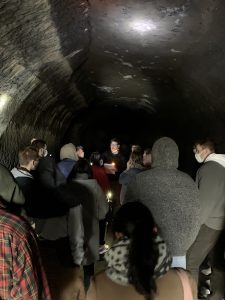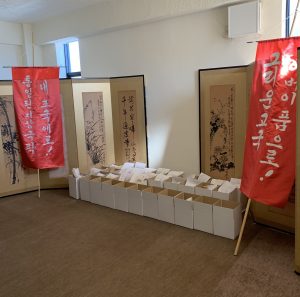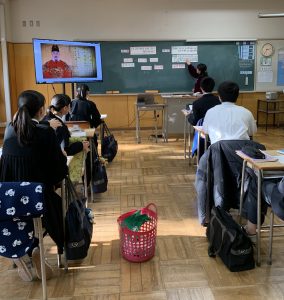“The history of Chongryon is a history of unity, solidarity, and struggle.” – Chairman of the Yokosuka Chongryon Branch, Jan. 17, 2019
In early 1956, construction was almost complete on what the Japanese authorities and general public thought was going to be a battery factory in what is now known as West Tokyo, but what at the time was farmland. When the “factory” was finished on April 10 of that year, however, a banner outside the perimeters announced that it was the new home of Korea University, which was previously a series of shacks attached to Tokyo First Korean High School.
This episode is part of the much longer and widely unknown anti-colonial struggle of Koreans in Japan, a struggle with implications and lessons for the whole world. It’s a struggle that, just like the Korean struggle more broadly, has been systematically isolated. As such, it’s a struggle that needs more international solidarity, particularly from those of us in the U.S. Yet it’s also a struggle that can provide hope and inspiration for all people fighting against colonialism and imperialism.
What’s more, it’s a struggle in which education—one of the foremost tasks of those interested in revolutionary transformation—is the motor.
Today there are around 800,000 Koreans living in Japan who are foreign nationals, or “special permanent residents” with either North or South Korean nationality. Japan is their home but, because of the U.S.-imposed division of Korea and the U.S. occupation of South Korea, they don’t have their homeland back yet.
In Japan they face legal, political, and economic discrimination, and especially since 2002, have even suffered physical attacks at the hands of the Japanese authorities and right-wing groupings. Chongryon, or The General Association of Korean Residents in Japan, is the organization—or better, movement—fighting for the rights of Koreans in Japan, supporting their livelihood, maintaining their culture and language in the face of ongoing colonialism, and working for the peaceful reunification of their homeland.
The origins of Koreans in Japan: Primitive accumulation, deception, and slavery
There are broadly three ways that Koreans came to Japan in the modern era, which together explain how a distinctive—yet by no means totally homogenous—Korean community came to reside in the colonial motherland. They also reveal the ways that Japanese colonialism and U.S. imperialism created the Korean diaspora more broadly.
Primitive accumulation
The Japanese conquest of Korea was a long process met with fierce resistance. It began in 1876, when Japan forced open Korea’s trade ports and began expanding into Ganghwa Island in the West Sea of the peninsula. Through a series of political and legal steps—each backed up by force or the threat of force—Japan annexed Korea in 1905 and, in 1910, formally subjected the peninsula to colonial rule.
The Japanese colonization of Korea was, like all colonizations, brutal. Japan violently repressed Korean society, politics, and culture, outlawing all manner of political organizations as well as the Korean language. The Japanese even forced Koreans to take up Japanese names.
A growing industrial power, Japan required colonies for raw materials and, increasingly, cheap labor. With Europe embroiled in World War I, Japanese industrial manufacturing displaced European manufacturing, which led to an export-driven boom in the 1910s. With the expanding economy, workers were fighting for a bigger share of the profits. Between 1914 and 1919, the frequency and intensity of strikes rapidly grew and intensified. Japanese capital needed to break the power of organized labor by importing cheap labor.
At the same time, Japan was in the process of dividing up common lands in Korea through a nationwide land survey project. They ultimately redistributed lands from peasants to landlords via inflated prices and taxes, reassessing values, redrawing boundaries, and instituting a registration system. This is an example of what Marxists refer to as “primitive” or “primary” accumulation, the process by which capitalists acquire capital and produce the proletariat not through their ingenuity and frugality, but theft and violence. The land survey bankrupted small peasant farmers, transferring land to Japanese and a very small number of collaborating Korean landlords.
As they were driven off the land, Japanese companies worked with the colonial police to recruit workers to Japanese factories. There was widespread deception in this process. Workers were promised high-paying jobs and freedom of travel, but arrived to find the opposite. Many demanded repatriation, but companies rarely, if ever, obliged.
With the end of World War I, the Japanese economy went bust, beginning with the March 1920 stock market crash, the worst economic crisis up until that time. Even though Korean labor was cheaper and more contingent than Japanese labor, they were the first to be fired. For the next few decades, those who were lucky enough to find work were employed as day laborers in large-scale urbanization projects, working the most dangerous jobs for the lowest pay. It was Koreans who built many of the dams, roads, and housing projects that still exist in Japan today.
Sexual slavery
The extensive Japanese sexual slavery network represents another aspect of the movement of Koreans to Japan. The Japanese military deceived and kidnapped hundreds of thousands of women to serve as sexual slaves to Japanese soldiers.
This practice couldn’t have been more brutal. The women were systematically raped and beaten dozens of times a day. When they became too sick, they were killed or left to die alone.
While these so-called “Comfort Women” were kidnapped from Japanese colonies from Taiwan to the Philippines, most came from Korea and Manhcuria (and a large percentage of people in Manchuria during this time were Korean).
The practice continued in the southern half of Korea after the Japanese empire collapsed in 1945 and the U.S. stepped in. In other words, when the U.S. took over control of Korea from Japan below the 38th parallel, they also took control of these rape stations. During the war against Korea, these stations served troops from the Republic of Korea as well as from the United Nations.
The struggle for justice for these women goes on and is an important part of the broader Korean peace and justice movement. So too does the repression of this struggle continue. The Japanese government has recently waged a campaign to get cities across the world to remove statues of and memorials to Comfort Women from San Francisco to Manila. They’ve even tried to influence U.S. textbook publishers to omit any mention of Japanee sexual slavery. Although all but a few dozen have already died, their spirit still pushes the Korean struggle forward.
Political unrest reverberated throughout these decades, as economic depression merged with anti-colonial demands. March 1, 1919 saw the launch of a massive Korean independence protest movement.
Two years before, the Bolshevik Revolution gave new form to the Korean struggle for liberation. Communists and anarchists began meeting in the borderlands of Russia, China, and Korea. In the early 1920s, a series of Korean radical labor unions were set up in Japan. In 1925, 12 of these unions merged into Roso, which by the next year had a membership over 9,000, and another 3 years later a membership of over 30,000. In response, Koreans were severely repressed in Japan, with their movements policed and highly regulated.
Forced labor
Despite the threat that the organized Korean population posed to interwar Japan, the Pacific War (World War II) brought the need for additional labor once more. With Japanese imperial ambitions mobilizing large segments of the Japanese adult male population, Japan brought upwards of 1 million Korean workers to make up for the labor shortages.
They utilized the National Mobilization Law—passed in 1938 to get the empire into gear for war—to forcibly conscript Korean workers and bring them to Japan, where they served as slave laborers. In some cases they were kidnapped from Korea, while in others they were deceived into coming to Japan for a brighter future. Once there, they had no control over their working and living conditions.
Working in munitions factories, construction, and mining, they also built secret underground bases to serve as plane storage and bunkers for the air force. Koreans, often children, built hundreds of thousands of miles of networks of tunnels with their hands and pick axes. Just before Japan’s defeat in 1945, the government ordered all documents related to the project to be burned, so no one knows how many died in the construction. For the last several decades, Japanese and Korean activists have been studying this issue. Scholars have discovered that the tunnels were used to store munitions during the U.S. war against Korea.
Many of these slave laborers perished in the atomic bombings of Hiroshima and Nagasaki. They are never acknowledged in Japanese history.
A Chongryon Buddhist Temple, together with civic groups in Japan and both Koreas, have found some of the remains, and are currently working to bring them to the DMZ Peace Park.
The collapse of the Japanese empire in Korea: Defeat and partial liberation
Japan’s unconditional surrender on August 15, 1945 didn’t directly equate to the liberation of Korea.
Since 1931, nationalist and communist guerrillas struggled in the mountains of Manchuria against the Japanese. Kim Il-Sung emerged as a particularly effective leader during this period, so much so that the Japanese had special detachments tasked with his assassination. As the guerrillas were sweeping through Manchuria and the northern part of Korea, the U.S. moved to ensure that they wouldn’t take the whole peninsula.
The night before Japan’s surrender, two junior U.S. officers, Dean Rusk and Charles Bonesteel, took a National Geographic map of Korea into a room. Neither had been to Korea or spoke a word of the language. They divided the country along the 38th parallel, which was roughly in the middle but allowed the U.S. to retain control of the capital, Seoul. The U.S. and Soviet Union had already agreed to temporarily divide the country in half, with each army occupying the respective territory. The division was to last up to five years, by which point both Soviet and U.S. troops would leave.
With Japan’s defeat, people’s committees sprung up spontaneously all across the Korean peninsula. In the north, these would form the basis of a provisional government, and the Soviet Union would more or less rubber stamp all decisions made by this indigenous power. In the south, by contrast, the U.S. set up a military dictatorship, flying in Syngman Rhee, who had been studying in Princeton and Harvard and hobnobbing with the U.S. political establishment for decades. The dictatorship violently suppressed the people’s committees and massacred the left.
It was evident to any observer that without U.S. military occupation, the nationalists and communists would win in Korea. As such, the U.S. moved to make the occupation permanent by holding elections in the south in 1948. Most of the population boycotted the election and the Soviet Union and provisional government in the north denounced the move.
In response to this artificial construction of the South Korean state, the Republic of Korea, the Democratic People’s Republic of Korea was established in the north on September 9,1948.
This served to heighten uncertainty and sharpen the struggle. Korea had been a united country for centuries and no one accepted the division into two states as legitimate or permanent. There is a general consensus that had the U.S. followed through with its initial agreement with the Soviet Union and allowed country-wide elections to take place, Kim Il-Sung would have won hands down. The U.S. certainly knew this, which again is why they created the South Korean state.
Koreans in Japan in a decade of uncertainty
By Japan’s defeat on August 15, 1945, there were between 2 and 2.5 million Koreans living in Japan. A government survey found that 80 percent of Koreans in Japan hoped to return home, but they were unable to for three reasons. First, the General Headquarters—the U.S. overseer commanded by Douglas MacArthur—wouldn’t let them bring any property with them. Second, those who did leave would not be allowed to return and visit their family that stayed. Finally, because Koreans had suffered under super-exploitation for decades, most did not have the means to repatriate.
Koreans in Japan were in a state of limbo. They, too, refused to accept the situation as legitimate or permanent. What’s more, around 90 percent hailed from the southern half of the peninsula. Some did return home to find a U.S. occupation, violence, chaos, disease, and extreme economic insecurity. In fact, communists in the southernmost part of the country—who were geographically closer to Japan than the DPRK—fled to Japan to escape the military repression of the Rhee dictatorship in South Korea.
For example, 40,000 Koreans went to Japan after the South Korean authorities, backed by the U.S. military administration, smashed a nationalist and communist uprising on Jeju Island in 1948-1949. At one point 4/5 of the island’s population lived in Osaka.
On October 15, 1945 nationalist, communist, and generally progressive Koreans in Japan formed Joryon, or the Federation of Koreans in Japan. Joryon increasingly looked to the provincial government in the north, and particularly the leadership of Kim Il-Sung, who was held in high esteem not just among Koreans, but also among Japanese radicals and intellectuals, and all progressive people of the world. Joryon thus had an alliance with the Japanese Communist Party (and indeed there was a long and complex history of cooperation between Korean and Japanese revolutionaries).
Education was the top priority for Joryon. Within a year there were hundreds of schools built with over 1000 teachers and 41,000 students. They made their own curriculum and published their own textbooks. They taught Korean history, language, dance, music, and politics.
The schools were set up to reclaim the Korean culture that Japan worked so hard to repress. It was also seen as preparation for an eventual return to a united Korea. The Japanese would later (and temporarily) embrace the repatriation efforts of Koreans to the DPRK out of a desire to get rid of the population they saw as “rebellious” and “ethnically inferior.” Before the repatriation ended in 1984, over 90,000 had returned to the DPRK. Many sent some family members in the hopes that Korea would soon be reunited. As a result, many Koreans in Japan today have relatives in the DPRK.
The Joryon schools represented a threat to the post-war order and many were shuttered in 1946-7. Then, coinciding with the formation of the DPRK and RoK, in 1948-49 the General Headquarters violently raided and disbanded Joryon and its schools, killing several students in the process.
Mindan (The Korean Residents Union in Japan), a pro-US & Japanese rival organization, formed in 1946. Mindan was—and still is—loyal to the Republic of Korea, and Mindan members are South Korean citizens. They have not suffered any state repression, although members have still faced anti-Korean racism and discrimination.
Chongryon: Fighting against discrimination and for peace and reunification
The U.S. war against Korea from June 1950 through July 1953 deeply entrenched the division of the peninsula. Koreans in Japan had to, in some sense, choose between the DPRK and the RoK. The overwhelming majority (around 90 percent) supported the DPRK, viewing it—instead of the U.S. puppet RoK—as the bearer of the Korean nation. After all, a popular and indigenous government ruled in the north, backed by the international prestige of Kim Il-Sung and other leading guerrilla fighters.
Under Japanese colonial rule, Koreans were Japanese nationals. But in 1952, their nationality was revoked. They lost voting rights, couldn’t travel, and were excluded from a range of employment opportunities. They were stranded. Moreover, many were now second generation, meaning that they had grown up and lived their whole lives in Japan.
There were no Japanese schools where anything Korean was taught or even where students could speak Korean. Anti-Korean racism was rampant throughout Japanese schools and society.
A new organization for progressive, communist, and nationalist Koreans in Japan was in the works since Joryon’s violent dissolution, but it wasn’t until the early part of 1955 that a new organization, Chongryon, came into being. It was officially founded on May 25 of that year. The organization was founded specifically to organize Koreans in Japan around the DPRK, which meant working for peaceful reunification and creating their own educational and cultural institutions in Japan.
Chongryon looked inward to its own community and outward to its homeland. It thus took a position of non-interference in Japanese politics, adhering to Japanese laws (and thus severing ties with the Japanese Communist Party).
With generous funding from the DPRK—all the more significant given that the DPRK was at the time rebuilding its infrastructure after the devastation of the war—Chongryon set about rebuilding hundreds of schools as well as associations, sports teams, and professional and cultural institutions. They even set up their own bank and insurance company.
It was in this setting that Koreans in Japan built the “battery factory,” or Korea University—the only Chongryon institute of higher learning.
Korean education in Japan today and the struggle against discrimination
Chongryon schools are relatively autonomous from Japanese control because they aren’t technically “schools.” Instead, under Japan’s School Education Act, they are considered “miscellaneous schools.” This means that they have their own curriculum but that they are self-funded, primarily through donations and tuition.
The schools are widely popular within the Chongryon community, but even Koreans in Japan who aren’t affiliated with Chongryon send their children to the schools so they can learn their own language, culture, and heritage, and learn in schools free of anti-Korean racism. This is particularly so with elementary and middle schools.
There are currently 10,000 students in Chongryon primary and secondary schools. The composition is varied: around 45 percent hold DPRK passports, 55 percent hold RoK passports, and the remainder hold Japanese passports. Yet this doesn’t mean that 45 percent support the DPRK, 55 percent support the RoK, and 10 percent support Japan. Being a DPRK foreign national carries an extra burden. They aren’t able to freely travel outside the country, are prevented from visiting South Korea, and face increased discrimination. Many obtain RoK passports but still support the DPRK. This allows them to travel to both North and South Korea, as well as other countries like the U.S. and Britain. Holding an RoK or Japanese passport isn’t a barrier to formal or informal Chongryon membership.
The autonomy of Chongryon schools comes at significant costs. Employers discriminate against those who hold degrees from Chongryon schools. Additionally, Japanese universities do not accept Chongryon degrees, and so students must pay for and pass an additional entrance examination.
In 2010, the Japanese government introduced a tuition waiver program for foreign nationals attending school in Japan. Students in Chinese and American schools, for example, have their education fully or highly subsidized by the government. The only schools excluded are Chongryon schools. This was de jure until 2013, when the Abe government made it official by revising a ministry ordinance. The official reason is that the government hasn’t been able to verify Chongryon’s curriculum (as the study was cut short by the Abe government). However, the government hasn’t asked to verify the curriculum of any other foreign school.
Local governments, however, sometimes provide subsidies for Chongryon schools. Most, however, have followed the national government’s lead and stripped subsidies.
Parents are also ineligible for tax exemption for donations made to Chongryon schools, unlike donations to all other foreign schools.
Such financial strangling tightens the noose around all of Chongryon and, by extension, the entire community of Koreans in Japan. With the Chongryon community excluded from so many sectors of the Japanese economy, parents aren’t able to make up the difference through tuition, which means operating budgets and student enrollment decrease.
At Tokyo First Korean High School, where fourth and fifth generation Korean students are taught by third generation Korean teachers, the operating budget is ¥2 million a year. Ninety percent comes from tuition and there is no government funding. Japanese high schools in the area get 50 percent of their funding from the Tokyo metropolitan government. The national government gives parents a ¥112,000 voucher, which covers tuition. Korean schools are the only schools ineligible for the voucher program.
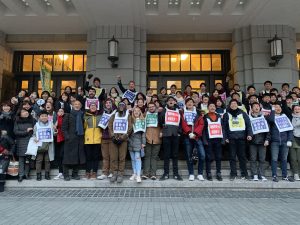
One of the weekly protests, held every Friday, against the Japanese government’s repression of Korean schools, on Jan. 18, 2019. Photo: Author.
Fed by the right-wing Abe government and its institutional attacks on the Chongryon community, racist and ultra-nationalist reactionaries have taken aim particularly at the most vulnerable: young students. In just one example, in 2009, 11 racists went to the front gate of a Chongryon elementary school in Kyoto and screamed things like “Cockroach Koreans!” at the students. After rallying for an hour, they proceeded to trash the soccer field and school auditorium. The group made three appearances at the school. The police showed up each time, but only stood by in silence.
A survey at a Chongryon middle and secondary school in Tokyo found that about 20 percent of students were harassed or threatened by right-wingers between 2003-2007.
Right-wingers have even attacked students with knives. Korea University students, for example, no longer wear traditional dresses outside of campus, because right-wingers slit their dresses with knives on the subway.
Throughout 2013, Japanese police conducted several raids on Chongryon. In February 2013, Japanese authorities raided Chongryon, deploying 250 police in more than 25 armored vehicles. Recently, a group of Korea University students returning from a school trip to the DPRK had all of their souvenirs confiscated at the Tokyo Haneda airport upon their return. The government has previously banned Chongryon officials from visiting the DPRK.
The Abe government regularly uses Korean students to try and gain leverage in negotiations with the DPRK. This is an attempt to divide Koreans in Japan from the DPRK, which warmly hosts Korea University students and Chongryon members on a regular basis, and maintains close ties to the Korean community there.
The Human Rights Association for Korean Residents in Japan is involved in legal battles against this apartheid system. They regularly appeal to the United Nations Human Rights Commission.
The future of Chongryon
After I first toured a Chongryon middle school in 2016, I met with the principle and vice-principle of the school. They asked us each our impressions. I was part of a delegation of overseas Koreans there to commemorate the 60th anniversary of the founding of Korea University, and I was the only U.S. citizen. When my turn came, I thought I would compare my observations with the state of U.S. schools.
I began by telling the administrators that, in the U.S., many people compare schools to prisons. At this point, my friend and colleague who was serving as my translator stopped, looking at me with a puzzled expression. After a few moments, another friend stepped in to translate. Afterwards, my colleague, who grew up in Chongryon schools and teaches at Korea University, apologized and explained what had happened. “I wasn’t able to put what you said into words because it was such an alien notion,” he said. “I couldn’t even comprehend what you had said in my head, even though I knew all of the words.”
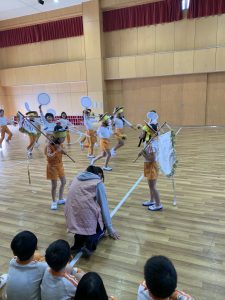
Kindergartners perform traditional Korean song and dance in a Chongryon elementary school. Photo: Author.
Chongryon schools are joyous environments where students learn to be proud of their identity and their nation. In addition to learning Japanese language, history, and literature, they study Korean culture, history, and politics. They eat Korean food in the lunchroom. They study contemporary Korean politics carefully and closely. They have rock bands that write, produce, and perform their own songs about the reunification of their homeland.
Chongryon schools accept all Korean students. There are no entrance exams and no one is turned away. The Chongryon Teacher’s Union regularly meets to study what’s known in the West as differentiated pedagogy (how to teach to each unique individual student).
It’s no surprise that my colleague was so puzzled that he couldn’t translate my remarks. Chongryon schools are the exact opposite of prisons. They serve as exemplars of the beauty and depth of the Korean yearning for peace and reunification. They provide educators and educational activists with a model of what genuine liberatory and decolonial education can be. What if all oppressed people in the U.S. had schools where they had total control over curriculum and pedagogy?
The Chongryon movement deserves solidarity from all over the world, but particularly from those of us in the U.S. It is the U.S. government that is the main obstacle to achieving peace and reunification on the Korean peninsula. The constant demonization and propaganda against the DPRK is a fundamental obstacle to a mass pro-Korean peace movement in the U.S. Telling the story of the Chongryon movement is one way we can work against this propaganda and stand in solidarity with Koreans in Japan and Koreans everywhere.
The author would like to thank his friends in Chongryon and at Korea University for their help with researching and editing this article.
